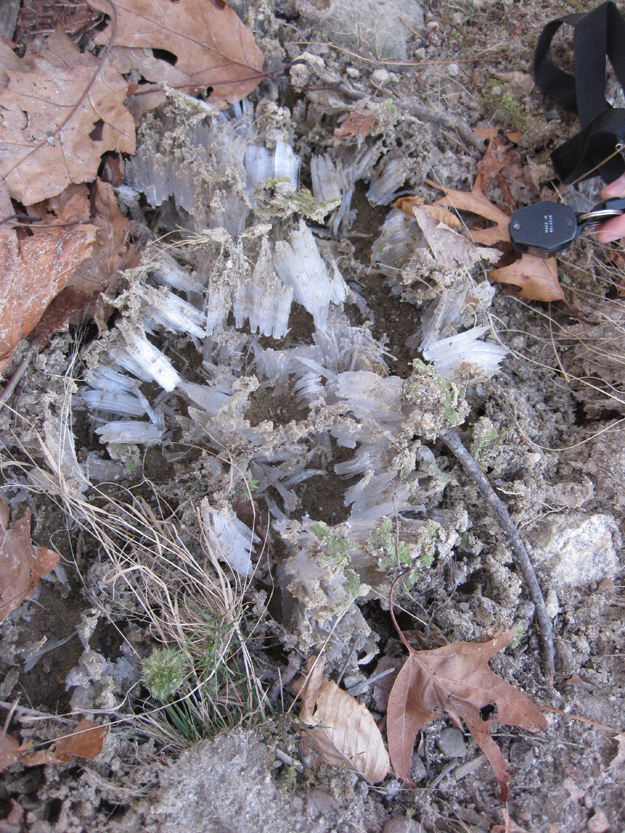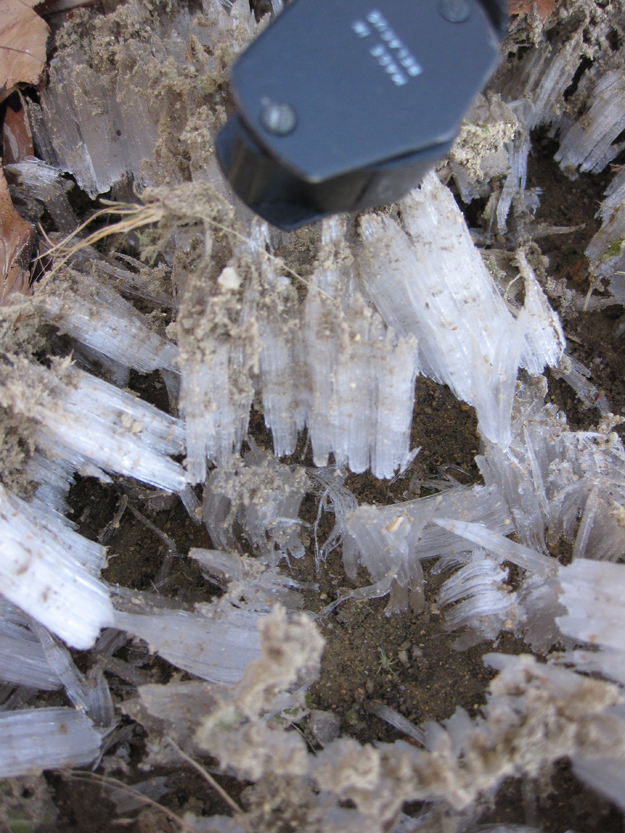22 November 2011
Asbest-ice
Posted by Callan Bentley
On our way up Compton Peak the other day, my field crew spotted some fibrous growths of ice growing up and out of the ground (perpendicular to the surface of the mountain):

(Joe’s hand lens for scale.)

The fibrous habit made me think of asbestos, and then I wondered whether the different shapes of ice crystals reflect different mineralogical arrangements of the H and O atoms, and if they are technically different minerals (you know: polymorphs, like calcite and aragonite, or graphite and diamond). Anyone got insight on that? Can we see these polymorphs in human-experiential meteorological conditions? Or are they crystallographically identical ice that just takes on a variety of habits? Mindat and WebMineral suggest the most common form of ice is hexagonal, but this site suggests (and shows) a variety of crystallographic forms, with clever names like “Ice II” and “Ice III.” Apparently lab experiments have produced varieties needing names going all the way up to Ice XV (that’s “15”), including Ice IX, which is different from Ice 9.


 Callan Bentley is Associate Professor of Geology at Piedmont Virginia Community College in Charlottesville, Virginia. He is a Fellow of the Geological Society of America. For his work on this blog, the National Association of Geoscience Teachers recognized him with the James Shea Award. He has also won the Outstanding Faculty Award from the State Council on Higher Education in Virginia, and the Biggs Award for Excellence in Geoscience Teaching from the Geoscience Education Division of the Geological Society of America. In previous years, Callan served as a contributing editor at EARTH magazine, President of the Geological Society of Washington and President the Geo2YC division of NAGT.
Callan Bentley is Associate Professor of Geology at Piedmont Virginia Community College in Charlottesville, Virginia. He is a Fellow of the Geological Society of America. For his work on this blog, the National Association of Geoscience Teachers recognized him with the James Shea Award. He has also won the Outstanding Faculty Award from the State Council on Higher Education in Virginia, and the Biggs Award for Excellence in Geoscience Teaching from the Geoscience Education Division of the Geological Society of America. In previous years, Callan served as a contributing editor at EARTH magazine, President of the Geological Society of Washington and President the Geo2YC division of NAGT.
Which is also different from Ice 9…
http://www.youtube.com/watch?v=4vqJCOO5im4
Sillimanice?
Callan, you found pipkrakes! A great example of how water moves through soil, which it must do to maintain a supply as it freezes to the bottom of the growing pipkrake and pushes it upwards.
Cool word! I love it. So if what we’re seeing here is a bit of pipkrakery, then I would guess that each fiber is NOT simply a single mineral crystal, but is instead a cylinder-shaped aggregate of crystals in the same way that spaghetti is a cylindrical aggregate of glutens and wheat particles. The earth has extruded the ice, just as a pasta maker extrudes spaghetti…?
The continuous, fibrous nature of the columns suggests that they are indeed very long crystals. The new water molecules are added at the bottom (right under the soil surface) and freeze into place in the growing crystal. The expansion on freezing pushes the crystal up. Your pipkrakes might record multiple nights of growth.
In fact, we did observe (but failed to photograph) several instances where all the adjacent pipkrakes showed a “waist” about halfway down, and we speculated that that thin spot represented the previous day’s relatively warm temperatures, and the thicker, longer bits above and below it were night-formed ice.
Oh, cool! I’ve observed “pipkrakes” before but cannot locate any pictures, and didn’t know anything about how they formed other than they were clearly ice!! Have wanted to use images in intro geology courses when discussing ice as a mineral (but not liquid water). Great!! (and I’ll credit your photos when I use them!)
Glad to be of use. E-mail me if you want higher resolution versions of the images.